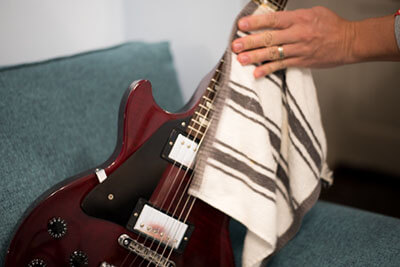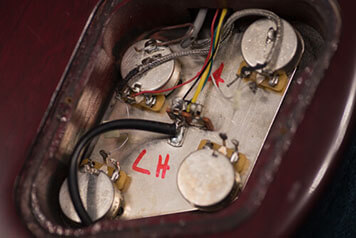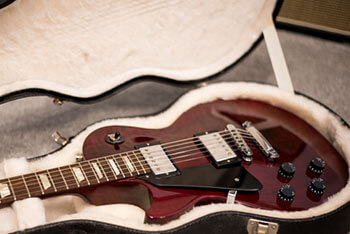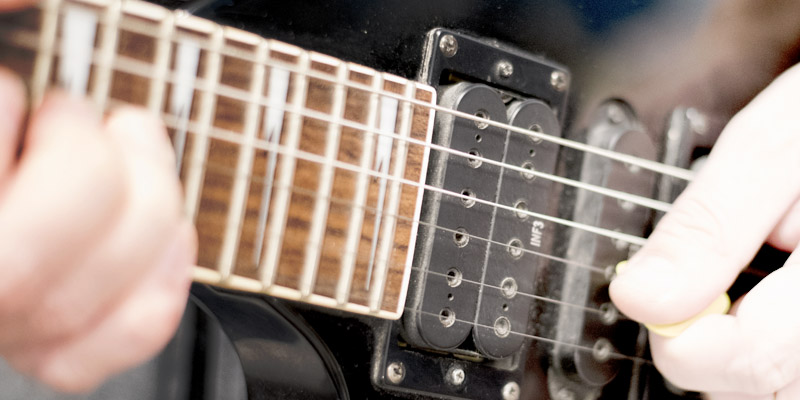Last Updated on October 7, 2025 by Chris
For anyone who’s into playing electric guitar, you’re basically gonna concentrate on picking up your favorite axe and having a good jam! Unfortunately, it’s a lot easier to forget about keeping it in good condition; maintaining it to keep it playing nicely for as long as possible.
So, let’s look at how to maintain a guitar; what can we do to prolong a good working guitar with a great-sounding tone?
Guitar maintenance is relatively easy; we just need to remember to do a few things after each session, and a few other things periodically to keep things sounding nice.
You’ll find you can keep your guitar sounding good for much longer if you follow a simple guitar maintenance routine.
Without further ado, here are 7 tips to bear in mind to help keep your guitar sounding fresh!
Please note: As an Amazon Associate I earn from qualifying purchases, so if you decide to buy anything through any of the links on this page, I’ll get a commission at no extra cost to you. If you do make a purchase, then thanks so much!
How To Maintain a Guitar
Wipe Your Guitar After Each Session

I don’t know about you, but after playing my guitar for a good while, my hands can get pretty sweaty!
Dampness in the strings can cause oxidation, which weakens the strings, making them more likely to break. Breaking strings during a burning solo sucks!
So, the first thing to do when maintaining a guitar is to give the neck and frets a wipe down with a dry cloth.
This’ll minimize any build-up of dirt from your fingers and skin around the frets. You can also rub the guitar body with a cloth to wipe away any dust and dirt, too!
Then I suggest wiping or cleaning our strings with a string cleaner, which can help prolong their life and keep them stronger for longer!
I recommend Fast Fret; your strings feel so smooth and clean afterwards!
Change Your Guitar Strings
After fitting a fresh set of guitar strings, our guitars sound so fantastic! As the strings get worn, though, we don’t really notice the change in tone; very slowly, their sound can gradually become dull and lifeless.
Even if you regularly clean your guitar strings, they’ll eventually wear out or even break. If they become discolored or feel rough, it’s definitely time to swap out your strings.
Do this regularly before they reach that stage, and you’ll have a lovely, bright, and fresh-sounding guitar.
I use Ernie Ball Skinny Top Heavy Bottoms for most of my guitars, which are .010 – .052 gauge strings.
If you’re not sure what gauge strings to use, just remember: the lower the numbers, the thinner and easier the strings are to play. A thicker, heavier string may give you a slightly darker tone, but is a bit harder to play.
Give It a Good Clean
Wiping your guitar after each time you play will help to maintain your guitar, but now and then it’s also good to give your guitar a more thorough cleaning than just a wipe down.
When you fit a new set of strings, it’s a good opportunity to clean your pickups, getting into all the nooks and crannies, and removing all the dust and debris from any cracks or crevices. Use a dry cloth and avoid using any fluids that could cause corrosion.
You can also clean the volume/tone pots if they make a scratchy sound when they turn. The first thing to do is to turn the knobs a few times and use the selector switch a few times to work loose any dust that has already gotten there.

An electrical contact cleaner can also help clear them of dirt.
If you have access to the pots on the back of the guitar, remove the backplate, give the pots a spray, and then repeat turning the knobs and flicking the pickup selector switch. Replace the knobs when finished.
If your guitar doesn’t have access to the back, then you may need to remove the pickguard to access the pots. Again, give them a spray, and then repeatedly turn the volume/tone knobs and flick the selector switch.
Also, give your fretboard a good clean. If it’s an unfinished fretboard, like ebony or rosewood, use a decent fret polish/oil. Many guitarists, including myself, like to use lemon oil; it’s an ideal solution for cleaning and conditioning your fretboard.
Rub it into the wood and around the frets, which will keep things nice and smooth and help with playability. Personally, I use Dunlop Fretboard 65 Ultimate Lemon Oil.
Avoid using polish or oil on a maple fretboard, as it can stain and discolor the wood.
If your fretboard has a finish, it’s best to wipe it with a damp cloth.
Electric Guitar Setup
Hopefully, when you buy a new electric guitar, it should’ve had a professional setup, so that when you first buy it, you should be able to play it without any issues. So what’s a guitar setup?
Basically, it fine-tunes your guitar so it functions as well as it can, making sure everything sounds right, and it irons out any inconsistencies so things don’t go wrong.
Ask at the store when you buy a new guitar if it’s had one. If it hasn’t, then they should sort one out for you. When maintaining a guitar, it needs to be in the best shape possible, so you can keep it at that quality!
Now and then, it’s good to get your guitar setup checked out by someone who knows what they’re doing, or again, you can ask at your local guitar store.
Buy a Guitar Case

How to maintain a guitar? If you don’t have one already, I recommend you buy a decent guitar case. Storing your guitar in a good-quality case, preferably a hard case, will keep dust and debris away from your guitar and stop any of that crud from getting into the pots and switches.
If it’s a hard case, you’ll also protect your guitar from any knocks or scrapes.
I must admit, I’m guilty of not doing this; I like to have easy access to my guitars, so I generally keep them on wall mounts and guitar stands. I also have more guitars than I do cases, so it’s not always practical. I do think it’s worth doing, though.
Keep Things at Room Temperature
Guitars hate extreme temperatures! High temperatures can cause warping or even cause glue joints to melt! You don’t want a glued-in neck to move out of place!
If you expose your guitar to temperatures that are too cold, it can affect your guitar’s finish. Bringing it into a warm room after it’s been in a cold car could crack the finish, so it’s a good idea to leave your guitar in its case for a while when moving it through different temperatures.
This allows your guitar to get used to the temperature.
So what’s the ideal guitar temperature? I’d say it’s a good idea to keep your guitars at room temperature; 21°C or 70°F is about right.
What About Guitar Humidity?
Try keeping your guitar at a fairly consistent humidity level. If it’s too humid, your guitar can absorb the moisture, causing the wood to expand and the finish to crack.
The same can be said if your guitar is kept somewhere too dry. The guitar can contract slightly, and, you guessed it, cause the finish to crack as well.
It’s recommended that the best humidity levels for an electric guitar range from around 40-50%. You can measure the humidity levels of your room with a humidity monitor.
If your room is too dry, then you can keep your guitar in a case along with a guitar humidifier.
Guitar Maintenance Summary
So there you have my 7 tips on how to maintain a guitar. Let’s briefly recap:
- Wipe your guitar after each time you play it.
- Change your strings regularly. Some change them every few weeks, some guitarists do so before every performance.
- Thoroughly clean your guitar periodically.
- Get your guitar professionally set up.
- Store your guitar in a good-quality guitar case.
- Store your guitar at room temperature, approximately 21°C (70°F).
- Maintain humidity at 40-60%. You can measure this with a humidity monitor.
What are your tips on how to maintain a guitar? If you have any guitar maintenance tips or tricks, please let us know in the comments below.


Good tips! Thanks 🙂
Now I can take very good care of all my guitars!!!!
Yes! It’s important to keep them maintained. This will keep them sounding better for longer!